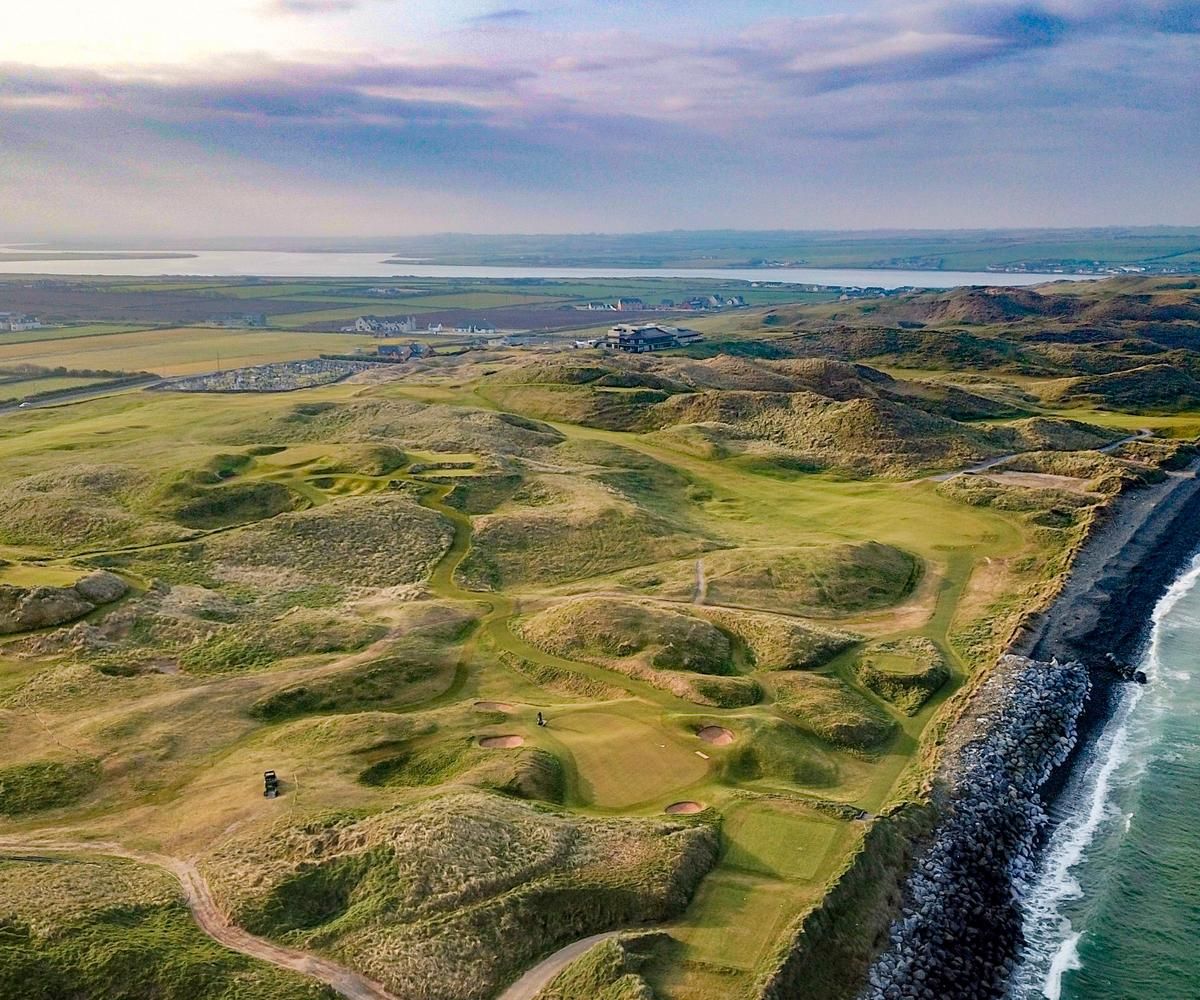What is Links Golf

Welcome to the world of links golf, a captivating style of the game that embodies the essence of golf’s rich heritage and the untamed beauty of coastal landscapes. Links golf is a unique and challenging form of the sport, originating in the coastal regions of Scotland, where the game itself was born. Unlike traditional parkland courses, links courses are shaped by the forces of nature, with undulating terrains, sandy soils, and the ever-present influence of the wind.
At its core, links golf is a testament to the harmonious integration of man and nature. These courses seamlessly blend into their surroundings, offering breathtaking views of the ocean and incorporating natural features like dunes, bunkers, and native grasses. The firm fairways and fast greens of links courses demand skill, strategy, and adaptability from golfers, testing their ability to navigate uneven lies, gusty winds, and cunning hazards.
In this article, we will explore the characteristics that define links golf, the influence of the coastal environment on gameplay, the key skills required to excel on links courses, a comparison between links and parkland golf, renowned links courses around the world, the prestigious Open Championship, tips for beginners venturing into links golf, and the exhilarating experience of spectating at a links golf tournament.
So, grab your clubs, prepare to be captivated by stunning vistas and challenging shots, and embark on a journey into the captivating world of links golf.

What are the Characteristics of Links Golf Courses?
When it comes to links golf courses, they possess distinctive attributes that set them apart from their parkland counterparts. Let’s take a closer look at these characteristics:
Natural Coastal Landscape
Links golf courses are nestled along the picturesque coastlines, showcasing breathtaking views of the ocean. They are intricately woven into the natural landscape, blending seamlessly with the rugged beauty of the surroundings.
Sandy Soil and Firm Fairways
One notable feature of links courses is the sandy soil that provides a solid foundation for the fairways. This firmness allows the ball to roll smoothly and promotes a style of play that relies on ground shots and creative shot-making.
Undulating Terrain
Unlike the relatively flat terrain of parkland courses, links courses often feature undulating landscapes with rolling dunes, natural contours, and subtle elevation changes. These variations in the topography add an element of challenge and strategic decision-making.
Bunkers and Dunes
Bunkers and dunes are integral components of links golf courses. The bunkers are strategically placed to guard the greens and fairways, demanding precision and careful consideration during shot selection. The towering dunes create a visually stunning backdrop while also acting as natural obstacles.
Wind as a Major Factor
One of the defining characteristics of links golf is the ever-present influence of the wind. The coastal locations of these courses expose players to strong gusts that can significantly impact ball flight, making shot selection and club choice critical factors in a player’s strategy.
Native Grasses and Vegetation
Links courses feature indigenous grasses and vegetation that thrive in the coastal environment. The rough areas often consist of wispy grasses and heather, presenting challenges for golfers who stray from the fairways. These natural elements enhance the aesthetic appeal of the courses while also affecting gameplay.
How Does the Environment Influence Links Golf?
The coastal environment plays a significant role in shaping the experience of links golf. Let’s explore how various environmental factors impact gameplay:
Coastal Location and Proximity to the Sea
Links courses benefit from their proximity to the sea, as the ocean breeze provides a constant challenge and affects ball flight. The briny air, combined with the panoramic views of the coastline, creates a distinct ambiance that adds to the allure of links golf.
Impact of Wind on Gameplay
The wind is a dominant force in links golf. Its strength and direction can change throughout a round, testing a player’s adaptability and shot-making skills. Learning to gauge and compensate for wind speed and direction is crucial to success on a links course.
Role of Natural Hazards like Water and Dunes
Links courses often feature natural hazards such as water bodies, dunes, and rough areas. These elements require careful navigation and add a strategic element to shot selection. Avoiding treacherous bunkers and negotiating undulating terrain become paramount to maintaining a competitive edge.
Maintenance Challenges Due to Saltwater Exposure
The proximity of links courses to the ocean presents maintenance challenges. The saltwater-laden air can have a corrosive effect on course infrastructure and vegetation, necessitating diligent upkeep to preserve the course’s integrity.
What are the Key Skills Required for Links Golf?
Links golf demands a unique set of skills from golfers to navigate the challenges posed by the coastal environment. Let’s explore the key skills required to excel in links golf:
Shot Creativity and Adaptability
In links golf, players must possess the ability to think creatively and adapt their shots to varying conditions. The undulating terrain, unpredictable winds, and natural hazards necessitate innovative shot-making techniques to overcome obstacles and achieve optimal results.
Precision and Control in Windy Conditions
The ever-present wind on links courses requires golfers to have exceptional control over their ball flight. Developing the ability to shape shots and control trajectory becomes crucial in order to counteract the wind’s influence and maintain accuracy.
Ability to Play from Uneven Lies
The undulating nature of links courses often leaves golfers with uneven lies. Players must develop the skill to adjust their stance, balance, and swing to effectively strike the ball from challenging slopes and awkward positions.
Judgement of Distances on Fast Greens
Links courses are renowned for their fast and firm greens, which demand precise judgment of distances. Golfers must develop a keen sense of touch and adapt their putting technique to navigate these challenging greens successfully.
Mental Resilience and Strategic Thinking
Playing links golf requires mental resilience and strategic thinking. The unpredictable weather conditions and strategic layout of the course demand a resilient mindset to handle setbacks and make informed decisions that maximize scoring opportunities.
How Does Links Golf Differ from Parkland Golf?
While links golf and parkland golf share the same objective of getting the ball in the hole with the fewest strokes, there are notable differences between the two styles of play. Let’s explore these differences:
Course Design and Layout
Links courses are characterized by their open and expansive layouts, typically featuring wide fairways that blend seamlessly with the surrounding natural landscape. On the other hand, parkland courses are often set amidst lush vegetation, with narrower fairways and defined tree-lined boundaries.
Playing Conditions and Terrain
Links courses have firm and fast-playing surfaces, thanks to the sandy soil and natural coastal elements. The ball tends to roll more, emphasizing ground shots and strategic positioning. Parkland courses, in contrast, offer well-manicured fairways, softer turf, and more emphasis on aerial shots.
Style of Play and Shot Selection
Links golf encourages a creative and adaptive style of play. Golfers must employ various shot types, including low punch shots, bump-and-run approaches, and creative chip shots to navigate the undulating terrain and overcome obstacles. Parkland golf, with its emphasis on aerial play, often requires higher trajectory shots to clear trees and other obstacles.
Impact of Weather Elements
While weather conditions can affect both links and parkland golf, the impact is often more pronounced in links golf. The ever-present wind, changing weather patterns, and exposure to coastal elements introduce a level of unpredictability and challenge that is distinct to links golf.
Famous Links Golf Courses Around the World
Links golf has a rich history and is celebrated through iconic courses around the world. Here are some renowned links golf courses that have captured the hearts of golf enthusiasts:
The Old Course at St. Andrews, Scotland
The Old Course at St. Andrews is widely regarded as the birthplace of golf and holds a special place in the hearts of golfers worldwide. With its historic charm, double greens, and challenging bunkers, it is a true testament to the essence of links golf.
Royal County Down Golf Club, Northern Ireland
Nestled against the backdrop of the stunning Mourne Mountains and the Irish Sea, Royal County Down offers a mesmerizing links experience. The course showcases dramatic dunes, blind shots, and a formidable challenge that tests golfers of all skill levels.
Royal Birkdale Golf Club, England
Royal Birkdale, located on the picturesque Northwest coast of England, is a classic links course that has hosted numerous Open Championships. With its strategically placed bunkers and undulating fairways, it provides a stern examination of a golfer’s skills.
Royal Dornoch Golf Club, Scotland
Located in the Scottish Highlands, Royal Dornoch is revered for its natural beauty and challenging layout. The course meanders through rugged dunes, offering breathtaking views of the North Sea and requiring golfers to showcase their shot-making prowess.
Ballybunion Golf Club, Ireland
Ballybunion, situated on the southwest coast of Ireland, is renowned for its dramatic cliffs, sweeping dunes, and challenging holes that demand precision and strategy. It has consistently been ranked among the top links courses globally.
Pebble Beach Golf Links, United States
Pebble Beach, situated along the scenic California coastline, combines stunning ocean views with challenging links-style holes. The course has played host to multiple U.S. Opens and is considered one of the most picturesque and iconic courses in the world.
The Open Championship: The Premier Links Golf Tournament
The Open Championship, often referred to simply as the Open, is the oldest and most prestigious tournament in links golf. Let’s explore the significance and allure of this premier event:
History and Significance of The Open Championship
The Open Championship dates back to 1860, making it the oldest major championship in golf. It is steeped in history and tradition, with a roster of legendary winners and iconic moments that have shaped the game of golf.
Rotating Venues and Iconic Courses
One of the unique aspects of The Open Championship is its rotation of venues. The tournament is held on various links courses across the United Kingdom, showcasing the diversity and beauty of links golf. St. Andrews, Royal Birkdale, Royal St. George’s, and Royal Liverpool are among the historic and revered venues that have hosted this prestigious event.
Notable Winners and Memorable Moments
The Open Championship has witnessed the triumphs of golfing greats throughout the years. From Old Tom Morris and Harry Vardon to Jack Nicklaus and Tiger Woods, the tournament has been graced by exceptional talent and produced unforgettable performances.
Influence on the Game of Golf Globally
As the oldest and most widely recognized links golf tournament, The Open Championship has a significant impact on the game of golf globally. It serves as an inspiration for aspiring golfers, showcases the beauty and challenge of links golf, and sets the standard for excellence in the sport.
How to Approach Playing Links Golf for Beginners?
If you’re new to links golf, approaching it with the right mindset and preparation can enhance your experience. Here are some tips to help beginners navigate the challenges of links golf:
Understanding the Course and Its Challenges
Before teeing off, take the time to study the course layout, noting the positioning of bunkers, dunes, and potential trouble areas. Understanding the challenges specific to the course will allow you to formulate a game plan and make informed decisions during your round.
Selecting the Right Clubs and Equipment
The unique conditions of links golf may require adjustments to your club selection. Consider carrying clubs that allow you to hit lower trajectory shots and navigate windy conditions effectively. Additionally, pack essentials like a windproof jacket, sturdy shoes for the firm terrain, and sunscreen to protect against the elements.
Adapting Your Swing and Shot Selection
Links golf demands versatility in shot selection. Practice adapting your swing to hit low punches, bump-and-run shots, and creative approaches around the greens. Experimenting with different shot types will give you more options to handle the challenges presented by the course.
Developing Strategies for Dealing with Wind
The wind is a constant companion on links courses, and learning to manage its influence is crucial. Pay attention to wind direction and adjust your aim and club selection accordingly. Embrace the wind as a strategic element and use it to your advantage when possible.
Learning from Experienced Players and Professionals
Observing and learning from experienced links golfers can provide valuable insights and tips. Watch professional tournaments held on links courses, study the strategies employed by top players, and seek guidance from local golf professionals who are well-versed in links golf.
Tips for Enjoying a Spectator Experience at a Links Golf Tournament
Watching a links golf tournament as a spectator can be a thrilling and memorable experience. Here are some tips to maximize your enjoyment:
Planning Your Visit and Getting Tickets
Research the tournament schedule and plan your visit accordingly. Purchase tickets in advance to secure your spot and take advantage of early bird discounts. Familiarize yourself with the tournament’s rules and regulations to ensure a smooth experience.
Familiarizing Yourself with the Course Layout
Obtain a course map or program upon arrival to familiarize yourself with the layout of the course. Identify key vantage points and areas of interest to make the most of your spectator experience. Consider following a specific group or player to witness their progress throughout the round.
Following the Action and Finding Good Viewing Spots
Position yourself strategically to catch the action. Explore different vantage points, such as elevated areas or greenside stands, to get a comprehensive view of the course. Plan your movements in advance to witness important shots and transitions between holes.
Interacting with Players and Getting Autographs
Take the opportunity to interact with players during practice rounds or after their rounds. Respect their focus and privacy but don’t hesitate to politely request autographs or engage in brief conversations when appropriate. It can be a memorable experience to connect with your favorite golfers.
Immersing Yourself in the Unique Atmosphere of Links Golf
Soak in the ambiance and atmosphere of a links golf tournament. Enjoy the stunning coastal views, indulge in local cuisine, and embrace the camaraderie among fellow golf enthusiasts. Immerse yourself in the rich heritage and passion that surrounds links golf.
Conclusion
Links golf is a captivating and challenging form of the game that celebrates the natural beauty and unique characteristics of coastal courses. From the undulating terrain and sandy soil to the ever-present wind and strategic shot-making, links golf offers a distinctive experience for golfers and spectators alike. Whether you’re a seasoned player or new to the sport, embracing the allure of links golf can lead to unforgettable moments on some of the world’s most renowned courses. So, venture out to the links, embrace the elements, and embark on a golfing journey that combines skill, strategy, and an appreciation for the breathtaking coastal landscape.





